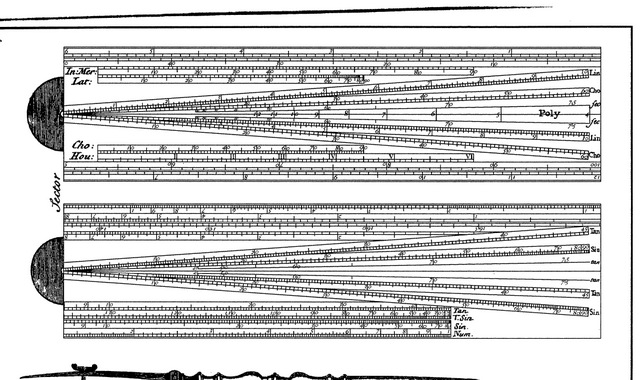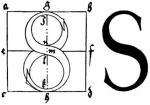
View showing the front and backside of a sector. Note the variety of scales for calculating different types of problems.
 ector, also called by the French, the compass of proportion. Sectors were the pre-industrial equivalent of a slide rule or a modern calculator. Prior the 19th century, geometry was the dominant means of resolving mathematical problems and the sector was applied to a wide range of applications from navigating the worlds oceans to plotting the trajectory of a cannon ball. Essentially it’s a pair of dividers with matching scales on each leg. All points along each leg has a matching point on the opposite, making every pair of points proportionally related to every other pair. Jim Tolpin has written about making and using a sector as a handy tool for simple layouts at the workbench. Both Jim and I have scoured historic craft literature to determine if sectors were actually used by tradesmen. They were common in drafting kits used by surveyors, and architects, but the only clear reference so far has been it’s inclusion in Thomas Sheratons The Cabinet-maker and Upholsterer’s Drawing-book : in four parts (1802). Sheratons focus on the tool seems to be more towards drawing than woodworking, so it’s conjecture to assume that craftsmen may have used them at the workbench. Still, I look at my Stanley folding rule and see essentially a quick and dirty sector for quick layouts. These folding rules were common in tool inventories and it’s not much of a stretch to think they might have been used in layouts at the bench. If you do run across any mention of a sector in use from historic craft literature, please let me know.
ector, also called by the French, the compass of proportion. Sectors were the pre-industrial equivalent of a slide rule or a modern calculator. Prior the 19th century, geometry was the dominant means of resolving mathematical problems and the sector was applied to a wide range of applications from navigating the worlds oceans to plotting the trajectory of a cannon ball. Essentially it’s a pair of dividers with matching scales on each leg. All points along each leg has a matching point on the opposite, making every pair of points proportionally related to every other pair. Jim Tolpin has written about making and using a sector as a handy tool for simple layouts at the workbench. Both Jim and I have scoured historic craft literature to determine if sectors were actually used by tradesmen. They were common in drafting kits used by surveyors, and architects, but the only clear reference so far has been it’s inclusion in Thomas Sheratons The Cabinet-maker and Upholsterer’s Drawing-book : in four parts (1802). Sheratons focus on the tool seems to be more towards drawing than woodworking, so it’s conjecture to assume that craftsmen may have used them at the workbench. Still, I look at my Stanley folding rule and see essentially a quick and dirty sector for quick layouts. These folding rules were common in tool inventories and it’s not much of a stretch to think they might have been used in layouts at the bench. If you do run across any mention of a sector in use from historic craft literature, please let me know.
George R. Walker






Interesting…just looking at Sheraton’s book today and reading this section about use of the sector, and his comments about use of geometry by the artisans of his age. He makes clear distinction between geometry as an intellectual pursuit and its practical application. There is little doubt that he taught his workers basic generative geometry, but left out the theory and proofs behind it.